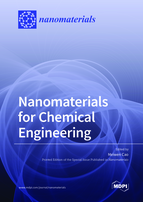Nanomaterials for Chemical Engineering
A special issue of Nanomaterials (ISSN 2079-4991).
Deadline for manuscript submissions: closed (28 November 2022) | Viewed by 30286
Special Issue Editor
Interests: peptide molecular design; self-assembly of biofunctional materials; pollutant water treatment; solution and interface aggregation behaviors of surfactant molecules; metal corrosion prevention
Special Issues, Collections and Topics in MDPI journals
Special Issue Information
Dear Colleagues,
Scientists and engineers have emphasized the study of nanomaterials in recent decades. The superior properties of nanomaterials are helping to greatly improve and even revolutionize the development of various technology and industry sectors. Despite their many advantages, challenges present in the control and design of nanomaterials with specific properties (morphology, size, porosity, conductivity, optical property, photoelectric property, chemical activity, etc.) to meet with their functional aims. The main applications of nanomaterials in chemical engineering are in catalysts, coatings, adsorption, sensors, drug delivery etc., which all represent fascinating yet challenging research topics.
This Special Issue welcomes contributions devoted to the synthesis and application of functional nanomaterials in chemical engineering, which includes the development of novel nanomaterials and synthesis methods, experimental characterization and computational modelling studies, as well as exploitation in devices and practical applications.
Prof. Dr. Meiwen Cao
Guest Editor
Manuscript Submission Information
Manuscripts should be submitted online at www.mdpi.com by registering and logging in to this website. Once you are registered, click here to go to the submission form. Manuscripts can be submitted until the deadline. All submissions that pass pre-check are peer-reviewed. Accepted papers will be published continuously in the journal (as soon as accepted) and will be listed together on the special issue website. Research articles, review articles as well as short communications are invited. For planned papers, a title and short abstract (about 100 words) can be sent to the Editorial Office for announcement on this website.
Submitted manuscripts should not have been published previously, nor be under consideration for publication elsewhere (except conference proceedings papers). All manuscripts are thoroughly refereed through a single-blind peer-review process. A guide for authors and other relevant information for submission of manuscripts is available on the Instructions for Authors page. Nanomaterials is an international peer-reviewed open access semimonthly journal published by MDPI.
Please visit the Instructions for Authors page before submitting a manuscript. The Article Processing Charge (APC) for publication in this open access journal is 2900 CHF (Swiss Francs). Submitted papers should be well formatted and use good English. Authors may use MDPI's English editing service prior to publication or during author revisions.
Keywords
- chemical engineering
- nanomaterials
- function
- application
- adsorption
- catalysts
- coatings
- pollutant treatment
Related Special Issue
- Nanomaterials for Chemical Engineering (Volume III) in Nanomaterials (3 articles)







